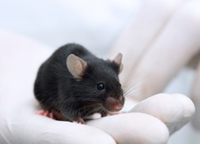
Why animals are used

Animals are used in research when there is a need to find out what happens in the whole, living body, which is far more complex than the sum of its parts. It is difficult, and in most cases simply not yet possible, to replace the use of living animals in research with alternative methods.
To advance scientific understanding
Adding to scientific knowledge through basic biological research helps us understand how living things work, and apply that understanding for the benefit of both humans and animals. The study of animals is a vital part of this research process. Many basic cell processes are the same in all animals, and the bodies of animals are like humans in the way that they perform many vital functions such as breathing, digestion, movement, sight, hearing and reproduction. To treat disease, doctors and scientists must understand how the healthy body works. This, in turn, leads to an understanding of what happens to the body when we fall ill and how this can be put right.A great deal of the knowledge of the body's anatomy and functions can be traced to scientific findings from animal research. Comparing different species and studying the differences and similarities between them is one way to gain insights. Even simple animals can be used to study complex biological systems such as the nervous or immune systems, which follow the same basic organisation and function in all animals. For example, much has been learnt about the function of neurons from studying the giant squid axon. Information from this sort of work can then be applied to higher animals and humans.
As models to study disease
Humans and animals share hundreds of illnesses, and consequently animals can act as models for the study of human illness. For example, rabbits suffer from atherosclerosis (hardening of the arteries), as well as diseases such as emphysema, and birth defects such as spina bifida. Dogs suffer from cancer, diabetes, cataracts, ulcers and bleeding disorders such as haemophilia, which make them natural candidates for research into these disorders. Cats suffer from some of the same visual impairments as humans. From such models we learn how disease affects the body, how the immune system responds, who will be affected, and more.While contributing to our understanding of diseases, animal models also enable researchers to explore potential therapies in ways which would be impossible in humans. Studying disease mechanisms in animal models leads directly to the development of new technologies and medicines that benefit both humans and animals.
Animals which are altered to create models of disease are known as induced models. For example, surgery which damages a particular section of the spinal cord in rats gives rise to symptoms like those seen in human patients with similar spinal cord damage. These animal models help researchers understand what happens in the body following this type of damage, and have been used in the development of new therapies.
Recent advances in genetic technology have allowed the development of transgenic animals, which have new genes inserted into their DNA, allowing them to develop human diseases which do not naturally affect them. In particular this has allowed mice to model many human diseases which were previously difficult to study.
To develop and test potential forms of treatment
Once researchers learn more about a particular disease, animals are used to develop and test these potential therapies as part of the applied research process. For example, medicines for Parkinson’s disease have been developed using animal models with induced Parkinson’s-like symptoms. Models such as these are an essential part of applying biological research to real medical problems, allowing new targets for disease intervention to be identified. Data from animal studies is essential before new therapeutic techniques and surgical procedures can be tested on human patients.Diagnostic tools such as scanners, and implants such as heart pacemakers or artificial hips, are safe and effective only because they were developed and tested in animals. Many surgical techniques, such as open heart surgery and heart transplants, rely on methods and equipment that were developed using animals.
To protect the safety of people, animals and the environment
New medicines require testing because researchers must measure both the beneficial and the harmful effects of a compound on a whole organism. A medicine is initially tested in vitro using tissues and isolated organs, but legally and ethically it must also be tested in a suitable animal model before clinical trials in humans can take place.The animal tests provide data on efficacy and safety. They not only identify potential safety concerns, but also determine the doses which will be given to volunteers and patients during the first human trials.
Testing on animals also serves to protect consumers, workers and the environment from the harmful effects of chemicals. All chemicals for commercial or personal use must be tested so that their effect on the people and animals exposed to them is understood. The chemicals that we use day-to-day can accumulate in the water, ground or air around us, and their potential impact on the environment must be researched thoroughly.
Page initially found at: Why animals are used